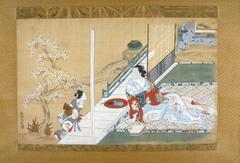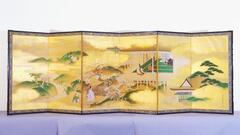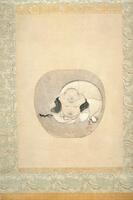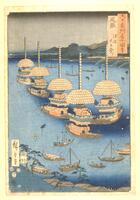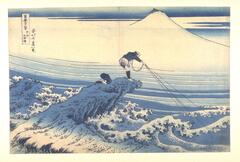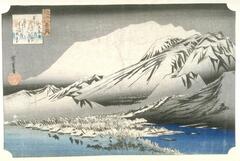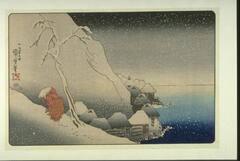17 Items in this Learning Collection
Collection Object
Collection Object
Collection Object
Collection Object
Collection Object
Collection Object
Collection Object
Collection Object
Collection Object
Collection Object
Collection Object
Collection Object
Collection Object
Collection Object
Collection Object
Copyright
All Rights Reserved
()
Hotei
Accession Number
1965/1.157
Title
Hotei
Artist(s)
Ogata Kōrin
Object Creation Date
circa 1700-1716
Medium & Support
ink and light color on paper
Dimensions
8 3/8 in x 8 7/8 in (21.3 cm x 22.5 cm)
Credit Line
Museum purchase made possible by the Margaret Watson Parker Art Collection Fund
Label copy
Copies and Invention in East Asia (August 17, 2019 - January 5, 2020)
Like the arhats, Hotei is a Buddhist figure that is both venerated and used as a decorative motif. Believed to be a Tang (618–907) or Song (960–1279) dynasty wandering monk, he became known for his fortune-telling abilities and his eccentric appearance and behavior. His name refers to the empty cloth bag he carries, which became a symbol of his lack of concern for material gain. In Japan he was grouped with six other divine figures from Buddhist and Japanese Shintō practices, known together as the Seven Lucky Gods. Depicted as a plump, bald monk carrying a walking stick and large sack, his image carried connotations of good fortune, but also of Zen Buddhist values. It was popular in painting, as well as personal accessories. This netsuke—a small carved ornament used to attach personal items to the sash (obi) of a kimono—would have been used as a sort of lucky charm.
Hotei (known in Chinese as Putai) is the fond nickname for a tenth-century Chinese monk named Qici, who attained legendary status as an exemplar of Zen ideals. Hotei is recognizable by his large belly and his equally enormous alms bag, which he carried everywhere. His very name is a pun: Hotei literally means “cloth sack”—and by extension, “glutton.”
Hotei became a favorite subject for Zen monk-painters in China and Japan as early as the thirteenth century. Artists delighted in the possibilities for visual punning, drawing both Hotei’s belly and his bag as enormous circles. An empty circle—a perfect geometric shape without beginning or end—is used in Zen as an abstract symbol representing the erasure of opposites, a fundamental Buddhist teaching. Here, Kôrin cleverly repeats the circle shape four times, in Hotei’s head and body, his sack, and the overall shape of the fan.
Kôrin, a native of Kyoto who is rightly regarded as one of Japan’s most inventive artists, normally painted themes drawn from classical Japanese literature, creating stunning decorative effects with bright mineral pigments. Towards the latter part of his life, however, he spent a sojourn in Edo where he took up the serious study of ink painting. This fan was probably produced in the final decade of his life.
(6/28/10)
(Japanese Gallery Rotation, Spring 2010)
Subject matter
Hotei (known in Chinese as Putai) is the fond nickname for a tenth-century Chinese monk named Qici, who attained legendary status as an exemplar of Zen ideals. Hotei is recognizable by his large belly and his equally enormous alms bag, which he carried everywhere. His very name is a pun: Hotei literally means “cloth sack”—and by extension, “glutton.”
Hotei became a favorite subject for Zen monk-painters in China and Japan as early as the thirteenth century. Artists delighted in the possibilities for visual punning, drawing both Hotei’s belly and his sack as enormous circles. An empty circle—a perfect geometric shape without beginning or end—is used in Zen as an abstract symbol representing the erasure of opposites, a fundamental Buddhist teaching.
Physical Description
The shape of the circle repeats four times in this painting. It appears in the plump body of Hotei, his head, his large white sack, and the overall shape of the fan.
Primary Object Classification
Painting
Primary Object Type
hanging scroll
Additional Object Classification(s)
Painting
Collection Area
Asian
Rights
If you are interested in using an image for a publication, please visit http://umma.umich.edu/request-image for more information and to fill out the online Image Rights and Reproductions Request Form. Keywords
circles (plane figures)
fans (costume accessories)
hanging scrolls
literary theory
1965/1.157
Title
Hotei
Artist(s)
Ogata Kōrin
Object Creation Date
circa 1700-1716
Medium & Support
ink and light color on paper
Dimensions
8 3/8 in x 8 7/8 in (21.3 cm x 22.5 cm)
Credit Line
Museum purchase made possible by the Margaret Watson Parker Art Collection Fund
Label copy
Copies and Invention in East Asia (August 17, 2019 - January 5, 2020)
Like the arhats, Hotei is a Buddhist figure that is both venerated and used as a decorative motif. Believed to be a Tang (618–907) or Song (960–1279) dynasty wandering monk, he became known for his fortune-telling abilities and his eccentric appearance and behavior. His name refers to the empty cloth bag he carries, which became a symbol of his lack of concern for material gain. In Japan he was grouped with six other divine figures from Buddhist and Japanese Shintō practices, known together as the Seven Lucky Gods. Depicted as a plump, bald monk carrying a walking stick and large sack, his image carried connotations of good fortune, but also of Zen Buddhist values. It was popular in painting, as well as personal accessories. This netsuke—a small carved ornament used to attach personal items to the sash (obi) of a kimono—would have been used as a sort of lucky charm.
Hotei (known in Chinese as Putai) is the fond nickname for a tenth-century Chinese monk named Qici, who attained legendary status as an exemplar of Zen ideals. Hotei is recognizable by his large belly and his equally enormous alms bag, which he carried everywhere. His very name is a pun: Hotei literally means “cloth sack”—and by extension, “glutton.”
Hotei became a favorite subject for Zen monk-painters in China and Japan as early as the thirteenth century. Artists delighted in the possibilities for visual punning, drawing both Hotei’s belly and his bag as enormous circles. An empty circle—a perfect geometric shape without beginning or end—is used in Zen as an abstract symbol representing the erasure of opposites, a fundamental Buddhist teaching. Here, Kôrin cleverly repeats the circle shape four times, in Hotei’s head and body, his sack, and the overall shape of the fan.
Kôrin, a native of Kyoto who is rightly regarded as one of Japan’s most inventive artists, normally painted themes drawn from classical Japanese literature, creating stunning decorative effects with bright mineral pigments. Towards the latter part of his life, however, he spent a sojourn in Edo where he took up the serious study of ink painting. This fan was probably produced in the final decade of his life.
(6/28/10)
(Japanese Gallery Rotation, Spring 2010)
Subject matter
Hotei (known in Chinese as Putai) is the fond nickname for a tenth-century Chinese monk named Qici, who attained legendary status as an exemplar of Zen ideals. Hotei is recognizable by his large belly and his equally enormous alms bag, which he carried everywhere. His very name is a pun: Hotei literally means “cloth sack”—and by extension, “glutton.”
Hotei became a favorite subject for Zen monk-painters in China and Japan as early as the thirteenth century. Artists delighted in the possibilities for visual punning, drawing both Hotei’s belly and his sack as enormous circles. An empty circle—a perfect geometric shape without beginning or end—is used in Zen as an abstract symbol representing the erasure of opposites, a fundamental Buddhist teaching.
Physical Description
The shape of the circle repeats four times in this painting. It appears in the plump body of Hotei, his head, his large white sack, and the overall shape of the fan.
Primary Object Classification
Painting
Primary Object Type
hanging scroll
Additional Object Classification(s)
Painting
Collection Area
Asian
Rights
If you are interested in using an image for a publication, please visit http://umma.umich.edu/request-image for more information and to fill out the online Image Rights and Reproductions Request Form. Keywords
circles (plane figures)
fans (costume accessories)
hanging scrolls
literary theory


